Teach Your Pup to Accept Handling All Over His Body
By Michele Welton, Dog Trainer, Breed Selection Consultant, Author of 15 Dog Books
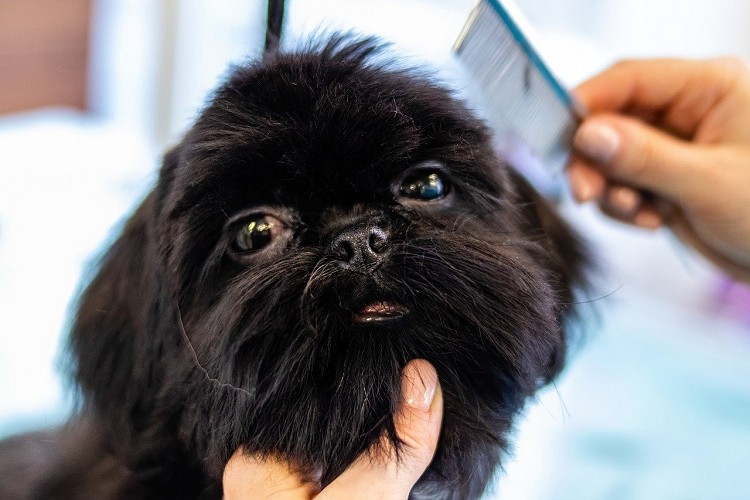
This article could also be titled:
"How to Handle Your Pup Without Getting Into World War 3."
Honestly, some dogs pitch a dramatic fit when their owner tries to examine some part of their body, or comb out mats, or brush their teeth, or clip their nails.
If that kind of behavior doesn't sound like much fun... it isn't.
 A dog who protests or grumbles or wriggles around when you open his mouth, peer into his ears, trim his nails, or pull a tick off his belly...
A dog who protests or grumbles or wriggles around when you open his mouth, peer into his ears, trim his nails, or pull a tick off his belly...
...is second-guessing your decisions about what is best for him. He doesn't yet trust you to handle the leadership role.
That's why this article is so important. It's not about the actual grooming process. It's about building the right leader-follower relationship, teaching your dog to trust you, and developing your own confidence that you can handle and control your pup – whether or not he understands why.
Dogs have the mental and emotional maturity of a toddler. Every parent has had to say to their 2-year-old, "Because I said so." With toddlers and canines, long-winded explanations get you nowhere. Toddlers and canines need to do what you say because you are in charge of their health, well-being, and safety. You know more than they do about what's best.
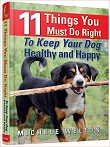 In my canine health book (which you can read online for free), I show you how to actually groom your dog – brushing and bathing, cleaning his ears and teeth, and clipping his nails.
In my canine health book (which you can read online for free), I show you how to actually groom your dog – brushing and bathing, cleaning his ears and teeth, and clipping his nails.
In the article you're reading now, we're going to focus on teaching your pup to accept being handled, to remain calm and quiet as you move his body into different positions and touch and feel all over his body.
You might be thinking, "But I don't need that, since I take my dog to a professional groomer."
No, you should still do everything in this article.
- First, because you want your pup to have the right (respectful) attitude toward you.
- Second, because you want to be sure that you can handle and control your pup even when he doesn't understand (or like) something.
- And third, because you shouldn't turn ALL of your dog's grooming over to someone else. You should be personally inspecting his teeth, eyes, ears, and paws on a regular basis. This is how you catch health problems early when they're still readily treatable.
Choose a handling/grooming area
Remember that dogs learn best through routines – doing things the same way, in the same order.
So when you're teaching these handling exercises, it will help your pup if you always go to the same place in your house. This will help him remember what happens there.

This table is too slippery for safety, and you would never stand this far away from a pup on a table. He could break his leg jumping off.
I like to use a table for handling and grooming. Dogs are usually more hesitant to act up when they're on a table. It's a new experience for them, and they might be concerned about falling off. So you have more control over the pup on a table.
The downside is that if you're not alert, a quick pup could actually jump or fall off!
So if you're worried about a high table, or if your dog is large, might you have a lower table such as an old coffee table? You can kneel beside a low table, or sit on a hassock or footstool or even on a sturdy box.
Make sure the surface is non-slip. You can buy a dedicated grooming table with a rubber surface, or on a regular table you might use a bath/porch mat with rubber backing.
If you must use the floor, either put down the same kind of non-slip mat or choose a carpeted area. Try to avoid doing these exercises directly on a slick vinyl or wood floor.
Introduction to the sitting position
First, you're going to place your dog into a sitting position. Now you might be thinking, "My pup already sits on command. Can't I just tell him to sit?"
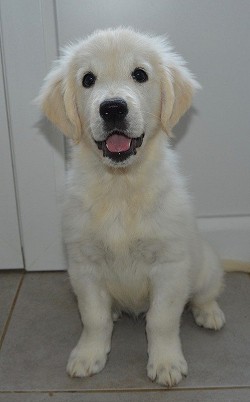
Well, the goal of handling exercises is to teach your pup to accept being handled.
There will be times in his life when you (or the vet) will need to move his body into different positions in order to provide medical care. By getting him used to being handled and moved about, you'll be making those experiences much less stressful for him. Also for you and the vet!
So yes, even if your pup knows how to sit, you should PLACE him in a sitting position.
There are two ways to do that:
- The Push. With your right hand, hold his collar to keep him steady. With your left hand, push down on his hindquarters (just behind his two hipbones, near his tail). Don't push down on his BACK. His spine and vertebrae are too sensitive for heavy pressure.
- The Fold. Place your right palm on his chest. Place your left hand (if he's small) or your left forearm (if he's larger) against the back of his rear legs (just above his "knees"). In one smooth motion, push his chest toward his rump while tucking his back legs forward to fold him into a sit over your hand or forearm. Don't worry, it sounds harder than it is!
Say "Sit" as you're placing him into the position. Yes, even if he already knows the word. The moment he's sitting, tell him "Gooood. Gooood dog." Calm voice. If you praise enthusiastically, he may get excited and try to jump around.
Keep your hands on him for a few seconds, then give him a treat and move right along to the next position.
Introduction to the standing position
- Hook the fingers of your right hand (palm UP) in his collar under his chin.
- Place your left hand (palm DOWN) under his stomach, way back in his groin area where his hindquarters are all bunched up as he sits there.
- Pull his collar gently forward and lift the BACK of your left hand gently into his stomach/groin area. This should raise him to a standing position. Say "Sta-a-a-nd" (drawing the word out) as you do so.
- Once he's standing, keep your left hand under his stomach to prevent him from sitting. Stroke his chest with the fingers of your right hand. Praise him: "Gooood boy. Goood." Keep him standing for just a few seconds, then give him a treat.
- Now guide him back into a sit again.

Alternate the standing and sitting positions several times. Keep him in each position for only a few seconds. And you're done for that session!
As the days go by....
Gradually take your hands away (but be ready to grab him should he try to jump). If he breaks the sit or stand position when you remove your hands, just reposition him. Be patient but persistent.
If he gets really fussy and squirmy and resistant and won't settle, add a sharp "AH-ah!" with a corrective technique if necessary. But return to praise once he settles.
Touching your dog all over his body
When your pup is reasonably proficient at holding the Sit and Stand positions, even if you still need to steady him a bit with one hand, we can add more handling.
With your pup in a sitting position...
- Run your hand all over his body, and your fingers through his coat. Praise calmly ("Goood") and give him a treat.
- Put one hand under his chin to lift his head up so you can peer into his eyes. Rub your index finger around the inner corner of his eyes, as though scraping off sleepy seeds. Praise calmly and give him a treat.
- Rub around the base of his ears. Peer inside his ears. Stroke the inside of his ears gently with your thumb. Praise calmly and give him a treat.
Still in a sitting position
Put one hand under his chin to steady his head. Say, "OPEN your mouth. OPEN." This doesn't mean he actually needs to open his mouth on command. It's just going to become a signal to him that you're going to be "poking around" in his mouth.
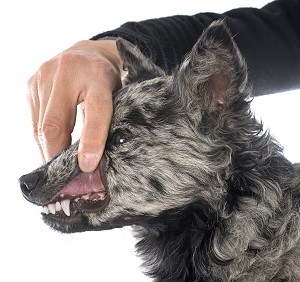
- Use the thumb of your other hand to lift up one side of his lip so you can peer at his teeth.
- Slide your fingers around his lips, getting him used to the odd sensation of his lips being pulled away from his teeth.
- Touch his teeth, gently rubbing them with the tip of your finger. Then praise calmly and give him a treat.
- Say "Paw... Paw" and raise one of his front paws. Spread his toes and touch the webbing between them. Gently grasp each toenail between your thumb and index finger, just for a moment. Fold the paw gently backward so you can touch the pad of his foot. Repeat with his other front foot. Praise calmly and treat.
With your pup in a standing position
- To handle his back feet, put your pup in his stand position. Say, "Paw... Paw" as you lift a rear foot and handle the toes, nails, and pads. Praise calmly and give him a treat.
These handling exercises should be repeated on a regular basis until your dog will sit still, or stand still, while you handle and touch any part of his body (including the testicles of a male pup). Your vet will love you for this!
If your dog tries to bite while being handled
Some young pups will mouth and nibble your hands as you're placing or holding them in position. This should be stopped calmly but firmly as explained in the linked article.
Actual growling or biting, though... that should NOT be happening and means your leadership position has not been established. Keep working diligently through my training program and putting everything else into practice. Or else call a local trainer (balanced, not "positive-only") who can evaluate your dog personally and try to figure out what's going on.
My best-selling books – now available FREE on my website
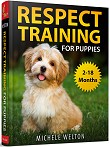 Respect Training For Puppies: 30 seconds to a calm, polite, well-behaved puppy is for puppies 2 to 18 months old. Your puppy will learn the 21 skills that all family dogs need to know. Click here to read for free.
Respect Training For Puppies: 30 seconds to a calm, polite, well-behaved puppy is for puppies 2 to 18 months old. Your puppy will learn the 21 skills that all family dogs need to know. Click here to read for free.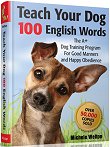 Teach Your Dog 100 English Words is a unique Vocabulary and Respect Training Program that will teach your adult dog to listen to you and do what you say. Click here to read for free.
Teach Your Dog 100 English Words is a unique Vocabulary and Respect Training Program that will teach your adult dog to listen to you and do what you say. Click here to read for free. 11 Things You Must Do Right To Keep Your Dog Healthy and Happy helps your dog live a longer, healthier life. Get my honest advice about all 11 Things before you bring home your new puppy, because some mistakes with early health care cannot be undone. Click here to read for free.
11 Things You Must Do Right To Keep Your Dog Healthy and Happy helps your dog live a longer, healthier life. Get my honest advice about all 11 Things before you bring home your new puppy, because some mistakes with early health care cannot be undone. Click here to read for free.
